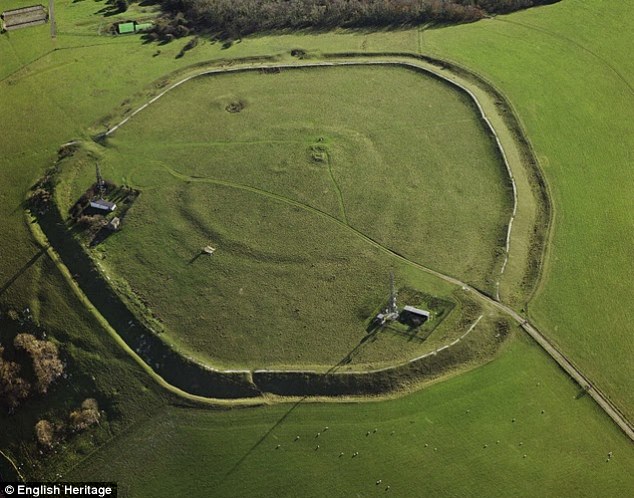This article forms the first in a series on the archaeology of Westgate and is adapted with their permission from an archaeological desk-based assessment prepared by SLR Consulting Ltd on behalf of Chichester College in 2013. The numbers on the above map refer to objects mentioned in the text below that have been found and registered in the Historic Environment Record (HER) for Chichester District.
Palaeolithic Period (c 500,000 – c 10,500 BP)
The earliest recorded human activity in the vicinity of Chichester, and Sussex as a whole, is at Boxgrove some 6km to our northeast. This activity is attributable to the hominid species Homo Heidelbergensis, dated to the temperate stage immediately preceding the onset of the Anglian Glaciation around 480,000 years BP. Remains associated with butchery and tool-making were buried beneath the pro-glacial gravels and sediments which are a characteristic feature of the harsh conditions along the south coast at this time. These gravels mask a buried chalk-cliff line which can be traced to the north of Chichester between Boxgrove and Lavant.
The channels of Chichester Harbour were formed during the repeated glacial and interglacial periods which continued up until the start of the Mesolithic period. During the last interglacial, around 125,000 years BP, sea level rise created marine conditions in Chichester Harbour and the deposition of raised beach sediments. The subsequent fall in sea level, coupled with solifluction during the late Devensian glacial period, led to sediment deposition in the harbour channels and the formation of estuarine conditions.
The majority of Palaeolithic activity in the area is represented by finds of worked tools, many of which exhibit signs of beach-rolling, which suggests a focus of activity along the raised shoreline towards the end of the Hoxnian period c. 200,000 BP. The marine and estuarine environments along this part of the coast during the Palaeolithic period would have represented a rich food resource and source of flint for tool making for the local inhabitants. It is considered that archaeological remains of this period are unlikely to be present in the Westgate area.
Mesolithic Period (c 10,500 – c 5,500 BP)
Known Mesolithic sites in the area of Chichester Harbour are restricted to chance finds of tool implements and two possible flint-working sites near Nutbourne Creek and Apuldram. It is believed that around this time the harbour would have comprised a series of deeply incised valleys with creeks running out to the coastline. Inland, as the soils stabilised following the end of the last glaciation, open grassland was replaced by beech and pine woodland which would have represented a range of new ecosystems for exploitation by humans.
Neolithic Period (c 6,000 – c 4,500 BP) to Bronze Age (c 4,500 – c 2,500 BP)
The Chichester District HER (Historic Environment Record) holds details of a single Neolithic asset, three Bronze Age (or possible Early Iron Age) and three Iron Age assets. Neolithic artefacts, including a worked flint blade, flake and core, were recovered during an archaeological evaluation 500m to the west of where the College now stands (marked HER 3951 on the above map).
A Middle- or Late-Bronze Age dagger was found at Westgate in 1931 (HER 2166), but no further details of the circumstances of its discovery are given. Two further Bronze Age assets are related to discoveries made during archaeological investigations at 6 St Bartholomew’s Close in 2003 and 2004 (HER 4170 and 4171).
These investigations demonstrated the presence of two ditches running on a northeast-southwest alignment, running approximately parallel to the college boundary and the River Lavant. Interpreted as a possible early flood defence, the ditches yielded Bronze Age/Early Iron Age pottery, worked flint and bone. A third ditch was located in 2004, alongside three pits (one truncated by the ditch and therefore earlier), and a spread of heat-shattered stone, possibly representing a degraded burnt mound. These finds are strongly indicative of the presence of an occupied site in the vicinity of Westgate in the Bronze Age.
Iron Age (c 2,600 BP – 1st century AD)
Three Iron Age assets are recorded within 500m of Westgate. These comprise two findspots of Early Iron Age pottery 430m to the east at the Palace Bastion (HER 2198) and at the West Gate itself (HER 2225), and Late Iron Age pottery found 500m west of the college (HER 3952). In the wider area pre-Roman habitation has been demonstrated at Mid Lavant to the north of Chichester, possibly associated with the Chichester Dykes, and numerous imported Gallo-Belgic remains of the period have been discovered within the historic core of Chichester at various locations.
Next part published on 1st January 2016: The Romans and Westgate.
